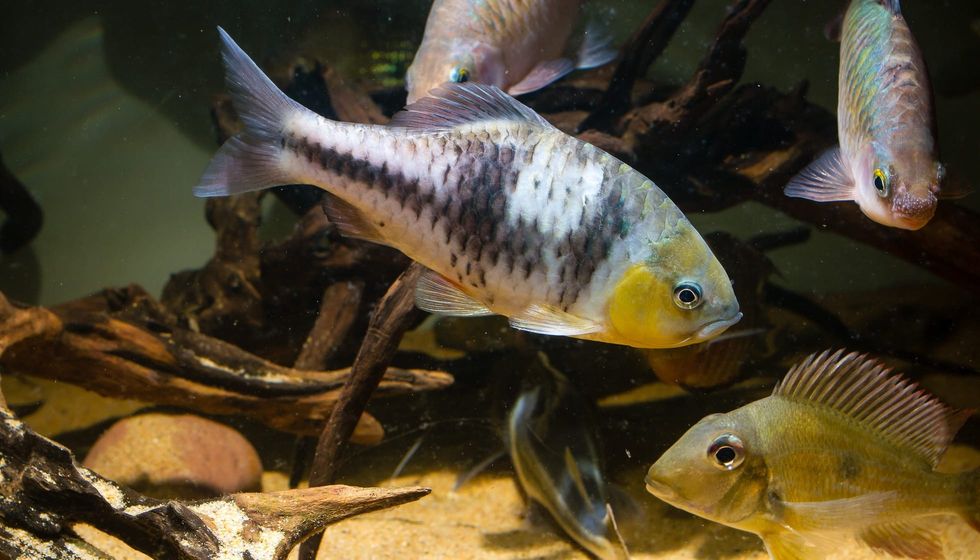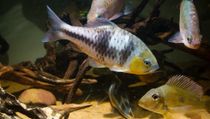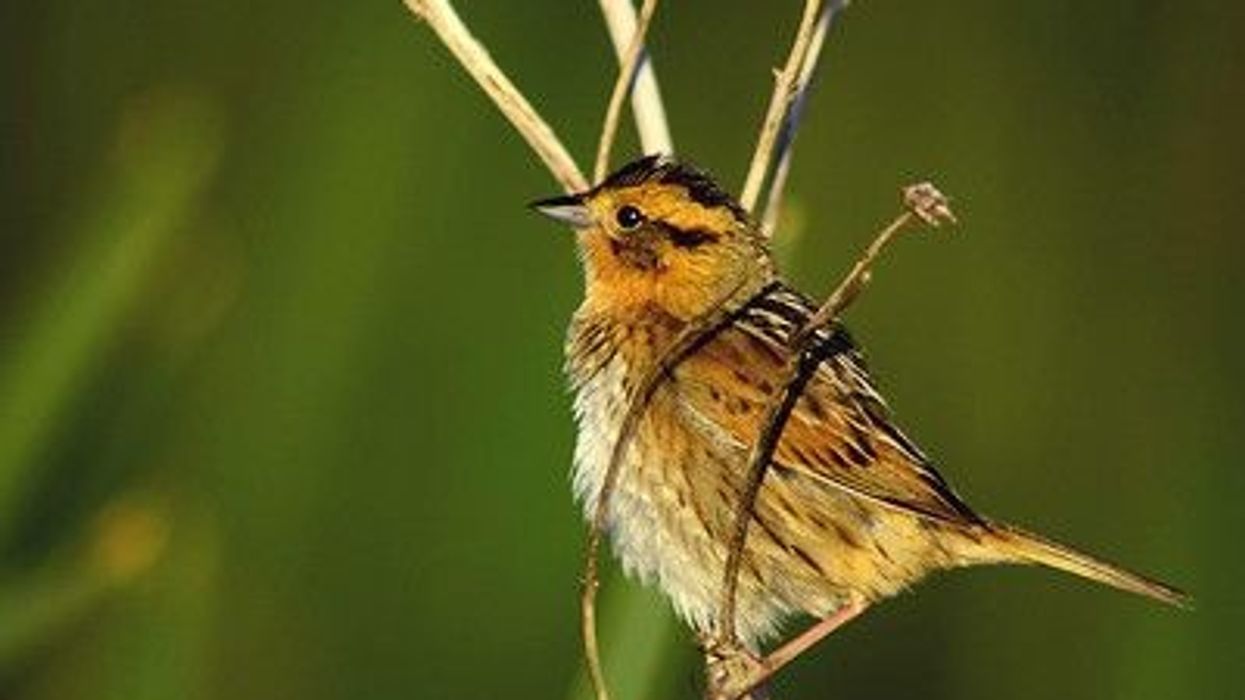Spanner barb are small fish who live in community tank and have a calm temper. They are naturally found in the freshwater bodies like streams and rivers across the south eastern parts of Asia in Borneo, Malay Peninsula, Sumatra and a lot of other places around.
They have normal colors on their body and have small and cute dorsal and ventral fins. They are kept in tanks because of their least problematic nature. They cause no problem during feeding, and while living with other fish.
They follow an omnivorous diet and consume both plant and animal materials as their food. Some of the favorite food of these active fish species are insects, algae, worms, zooplankton and phytoplankton.
This was just the beginning. More interesting information are waiting for you in the descriptions ahead. Keep reading!
For more relatable content, check out these rosy barb facts and giant guitarfish for kids.
Spanner Barb Interesting Facts
What type of animal is a spanner barb?
Spanner barb (Barbodes lateristriga) is a type of fish. They are aquarium fishes who are small in size and can be found across Malay Peninsula and islands of Borneo.
What class of animal does a spanner barb belong to?
The spanner barb belongs to the class Actinopterygii. Further it belongs to the order Cypriniformes, family Cyprinidae and genus Barbodes. The scientific name of this species is Barbodes lateristriga also known as Puntius lateristriga and Barbus lateristriga and Systomus lateristriga.
How many spanner barbs are there in the world?
Spanner bard (Barbodes lateristriga) are small aquarium fishes who fall under the conservation status of Least Concern. Their exact population count is unavailable at this moment. They happen in enough quantity across southern parts of Thailand, Malaysia, Sumatra and Java and some islands in the South China Sea.
Where does a spanner barb live?
Aquarium fish spanner barb (Puntius lateristriga) are found across the southeast Asia waters. They are tropical fish species who live in flowing water bodies like streams and can be seen on rocks and boulders. They also live in tank with size around 48 in (1.2 m) with a standard pH level of 6.0-6.5.
What is a spanner barb's habitat?
Spanner barbs (Puntius lateristriga) are small tropical fish species found across southeast Asia in freshwater bodies like streams. They happen in adequate quantity and can be found in southern parts of Thailand, Malaysia, Sumatra and Java and some islands in the South China Sea.
They are also native to Malay Peninsula and the islands of Borneo. In short, the distribution range of their natural habitat is widespread. They are not endemic to one region as they are kept in aquariums all over the world.
Who do spanner barb live with?
Spanner barb (Puntius lateristriga) in the family Cyprinidae show both social and solitary behavior depending on their age. Spanner barb adults show a solitary behavior and mostly stay alone. They can be found in small groups sometimes. Young fishes on the other hand are more social and can be found in quality groups.
How long does a spanner barb live?
Spanner barb (Barbus lateristriga) are aquarium fishes who live up to an average age of eight years. They carry a peaceful nature and can be seen active and happily swimming in their natural habitats.
How do they reproduce?
Spanner barb (Systomus lateristriga) in the family Cyprinidae are some careless spawning fishes. For making their breeding successful in a tank, it needs an experienced aquarist.
The spawning happens when they feel comfortable. And it can be triggered by supplying them with the correct environment. Their breeding can be executed in both pair and in group.
Setting up a good spawning environment includes dim lighting, neutral to slight acidic water pH with temperature of the water between 20–28 °C. The size of the aquarium can vary from cozy to big.
If they are breeding in groups, then bigger tanks are required. Spanner barb fishes lay their eggs in water and simply abandon them. They tend to eat their own eggs so it is important to remove all the adults from the tank after spawning.
The egg sinks into the water and gets collected at the bottom of the tank. The eggs generally hatch in one to two days and after three or four days, fry can be seen swimming freely in the tank.
What is their conservation status?
According to IUCN red list, spanner barb fish species are considered under the conservation status of Least Concern. They have a good population in the southeast asian provinces.
Spanner Barb Fun Facts
What do spanner barb look like?
Spanner barb are small tropical fish species found across the wild in southeastern part of Asia. They are famous aquarium fishes for their less demanding nature.
They are simple looking fish who are active and energetic. Their body is mainly siver colored with a bluish or orangish touch to it. In their body there are two black vertical stripes and one horizontal stipe at the forward end.
There are no more special color patterns on their body. All the fin present on their body are small and beautiful.
They have a small dorsal in fin and small ventral fins. The dorsal fin is situated in the middle of their back and the ventral fins namely the pelvic and pectoral fins are situated in their respective positions on the underbody. The tail is also small in size.
The are small tropical fish who grow to an average length range of 7.1 in (18 cm) with an average weigh range of 2.7 oz (77.5 g). They are non problematic fish species who can be easily kept as pets.

*Please note that this is an image of a Rosy Barb, not a Spanner Barb specifically. If you have an image of a Spanner Barb, then please let us know at hello@kidadl.com.
How cute are they?
They are small fish who seem very cute and adorable. Though they have less colors on their body, their tranquil nature and less demanding nature make them loveable pets.
How do they communicate?
Fish can't communicate vocally. They either communicate through body language or release chemicals like pheromones. They have their lateral line segment organ ranging from gills to the tail, which is very sensitive. Using this, they can read even the minute vibrations that happen in the water.
How big is a spanner barb?
Spanner barb are small tropical fish who are commonly kept in aquariums. They can be easily kept as pets because of their small size and peaceful nature. They grow to an average length of 7.1 in (18 cm) and can weigh around 2.7 oz (77.5 g).
How fast can a spanner barb swim?
There are no exact information about how fast these small aquarium fishes can swim.
How much does a spanner barb weigh?
Spanner barb are small fish who are 7.1 in (18 cm) long and have an average weigh of 2.7 oz (77.5 g).
What are the male and female names of the species?
There are no separate names for the males and females of this species. They show sexual dimorphism and females are comparatively larger than males. The male fishes on the other hand have brighter colors on their body compared to females.
What would you call a baby spanner barb?
Like all other baby fish, baby spanner barb is also called fry or young ones. They stay in group and search for food.
What do they eat?
Spanner barb fish follows an omnivorous diet and eats anything that comes their way. Their diet includes both plant and animal particles. When in tank, they consume both fresh and frozen food and cause no trouble. Some of their favorite food items are insects, worms, algae, zoo and phytoplankton.
Are they dangerous?
Not at all. They are peaceful and calm fishes who can easily live in a community aquarium. They are very active but cause no tantrums. They are too small to prove dangerous to humans.
Would they make a good pet?
Yes they make awesome pets. They are famous for their non problematic behavior.
They cause no tantrums while feeding them as they eat whatever they are served. They can be a bit restless if kept alone in a community tank so it's better to keep them in small groups. They can manage in a bit higher or lower temperature and water hardness.
Did you know...
Spanner barb and filament barb are related in terms of size. Both the species are around 7.1 in (18 cm) in body size. They are only related by size but have different colors on their bodies.
There is no specific information about how many eggs a spanner barb can lay.
What fish can live with barbs?
Spanner barb are barb species who are tranquil fish and can easily manage in community aquarium. It is better to keep them with even sized and non aggressive fish species. Cherry barbs and clown loaches (a type of loach fish) are some fishes that do well with them.
What size tank do barbs need?
The aquarium size for barbs depends on how big the barb is. The aquarium size can be from 10-50 gal. Small barbs like gold and cherry barbs can be kept in 15-20 gal tank.
A little bigger barb species like the tiger barbs are usually kept in 30 gallons tank. Denisonii barbs need a spacious tank because of their roaming habits. They usually need tank of size around 50 gal.
Here at Kidadl, we have carefully created lots of interesting family-friendly animal facts for everyone to discover! For more relatable content, check out these parrotfish facts and tilefish facts pages.
You can even occupy yourself at home by coloring in one of our free printable barb coloring pages.









